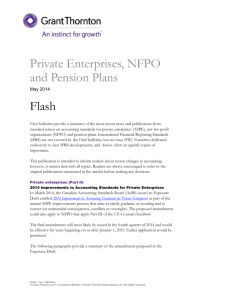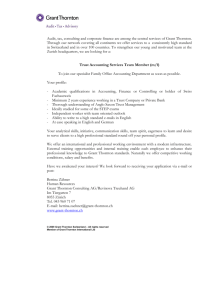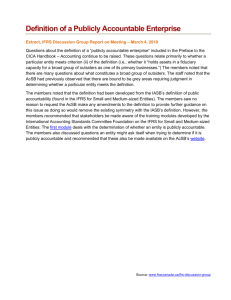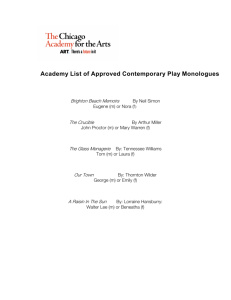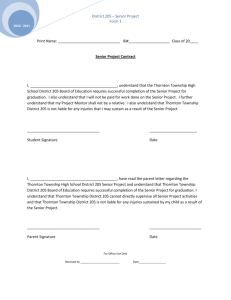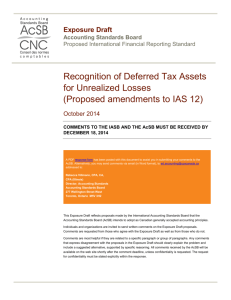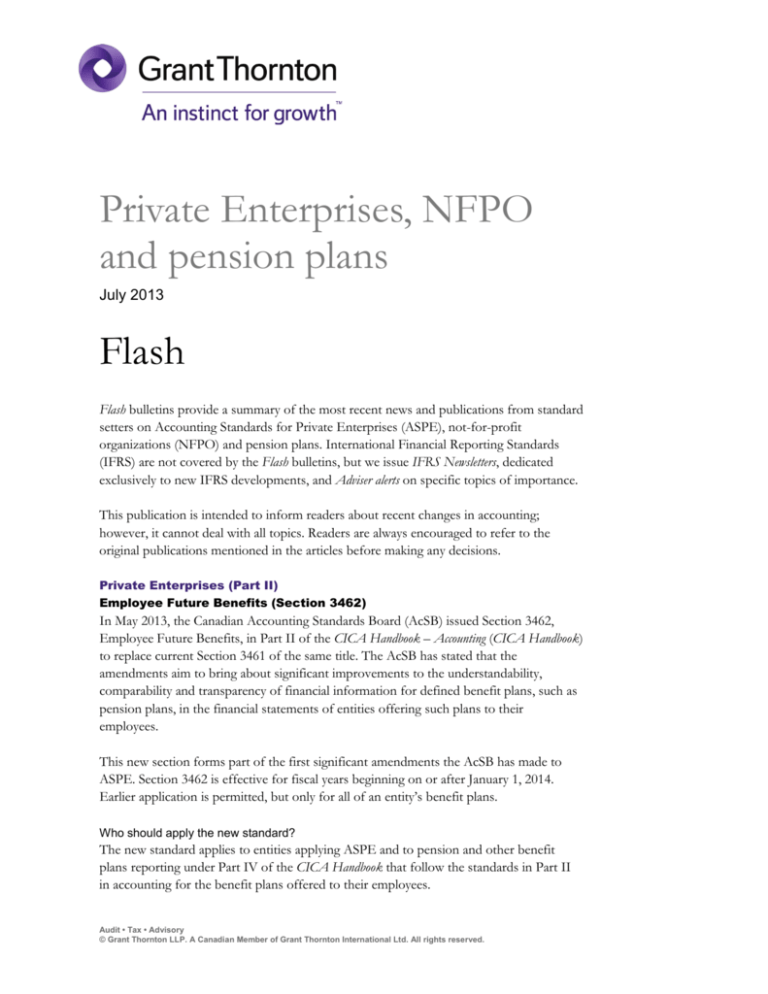
Private Enterprises, NFPO
and pension plans
July 2013
Flash
Flash bulletins provide a summary of the most recent news and publications from standard
setters on Accounting Standards for Private Enterprises (ASPE), not-for-profit
organizations (NFPO) and pension plans. International Financial Reporting Standards
(IFRS) are not covered by the Flash bulletins, but we issue IFRS Newsletters, dedicated
exclusively to new IFRS developments, and Adviser alerts on specific topics of importance.
This publication is intended to inform readers about recent changes in accounting;
however, it cannot deal with all topics. Readers are always encouraged to refer to the
original publications mentioned in the articles before making any decisions.
Private Enterprises (Part II)
Employee Future Benefits (Section 3462)
In May 2013, the Canadian Accounting Standards Board (AcSB) issued Section 3462,
Employee Future Benefits, in Part II of the CICA Handbook – Accounting (CICA Handbook)
to replace current Section 3461 of the same title. The AcSB has stated that the
amendments aim to bring about significant improvements to the understandability,
comparability and transparency of financial information for defined benefit plans, such as
pension plans, in the financial statements of entities offering such plans to their
employees.
This new section forms part of the first significant amendments the AcSB has made to
ASPE. Section 3462 is effective for fiscal years beginning on or after January 1, 2014.
Earlier application is permitted, but only for all of an entity’s benefit plans.
Who should apply the new standard?
The new standard applies to entities applying ASPE and to pension and other benefit
plans reporting under Part IV of the CICA Handbook that follow the standards in Part II
in accounting for the benefit plans offered to their employees.
Audit • Tax • Advisory
© Grant Thornton LLP. A Canadian Member of Grant Thornton International Ltd. All rights reserved.
Flash – July 2013
2
Due to comments the AcSB received relating to the Exposure Draft on Section 3462, the
AcSB reconsidered the applicability of some of the proposals to NFPO and a separate
Exposure Draft on a new section on reporting employee future benefits by NFPO was
issued in June 2013. A description of the proposals is provided in the article Reporting
Employee Future Benefits by Not-for-Profit Organizations within this issue.
What are the main changes?
Accounting
Entities will no longer be able to defer the recognition (in the income statement) of gains
and losses arising from defined benefit plans: the deferral and amortization approach
currently offered in ASPE has been eliminated. Consequently, the defined benefit liability
or asset presented on the balance sheet will be equal to the defined benefit obligation less
the fair value of the plan assets, adjusted for any valuation allowance in the case of a net
asset. In addition, actuarial gains and losses and past service costs (e.g., plan amendments)
will be immediately recognized in net income (loss) (these items are components of the
category “remeasurements and other items”). The concept of “expected rate of return on
plan assets” has also been eliminated. The impact of these changes is similar to that of the
immediate recognition approach currently provided for in Section 3461 and will result in
the volatility of the defined benefit plans expense and net income (loss).
Defined benefit obligations
Defined benefit obligations may be measured using either the funding valuation or the
valuation prepared for accounting purposes. This choice is an accounting policy decision
that should be applied systematically to all defined benefits plans. If a funding valuation
does not exist for a defined benefit plan, an entity must use the valuation prepared for
accounting purposes. The valuation prepared for accounting purposes is generally based
on principles similar to those applied using the deferral and amortization approach
currently provided for in Section 3461.
The following example illustrates one possible impact of the new model might have on
the defined benefit liability (asset):
Defined benefit liability (asset)
components
Defined benefit obligation
Less: plan assets
Plan deficit
New model: Valuation
prepared for
accounting purposes
(Section 3462)
Former model: Deferral
and amortization
approach (Section
3461)
$10,000
$10,000
$9,500
$9,500
$500
$500
Less: unamortized actuarial losses
-
$1,500
Unamortized past services cost
-
$400
Defined benefit liability (asset)
$500
Audit • Tax • Advisory
© Grant Thornton LLP. A Canadian Member of Grant Thornton International Ltd. All rights reserved.
($1,400)
Flash – July 2013
3
Measurement date
The measurement date for plan assets and for the defined benefit obligation is the balance
sheet date: no other date is permitted. Under Section 3461, according to the deferral and
amortization approach, the measurement date could have been within a three-month
period preceding the balance sheet date.
A full actuarial valuation of the defined benefit obligation shall be determined at least
every three years but may occur more frequently, for example, when a significant event
takes place. In the years between full valuations, the entity uses a roll-forward technique to
estimate the defined benefit obligation. Note that, upon adoption of Section 3462, the
discount rate will only be changed during full actuarial valuations.
Disclosures
The new standard requires additional disclosures relating to the changes made to defined
benefit obligation measurement and from the volatility of net income (loss). Entities shall
provide the amount of remeasurements and other items (e.g., actuarial gains and losses,
adjustments to the valuation allowance as well as and gains and losses arising from plan
amendments, curtailments and settlements) recognized in the income statement for the
period, if this amount is not presented on the face of the income statement. The nature
and effective date of the most recent actuarial valuation used shall also be mentioned.
Other changes
A change has also been made to defined contribution plan accounting. Henceforth, past
service costs (resulting from amendments to the plan, for example) shall be recognized
immediately in net income (loss) while Section 3461 required their deferral and
amortization to net income (loss) over a period defined in the standard.
Significant consequential amendments include changes to
•
Section 1500, First-time Adoption, to permit a first-time adopter to apply the
transitional provisions in new Section 3462 and eliminate some exemptions for
employee future benefits relating to deferred recognition that are no longer necessary;
•
Section 1506, Accounting Changes, to exempt the accounting policy choice related to
the funding valuation or accounting valuation from meeting the relevance and
reliability criteria;
•
Section 1520, Income Statement, to require that “remeasurements and other items”
and termination benefits be presented separately on the face of the income statement
or disclosed in the notes to the financial statements; and
•
Section 1582, Business Combinations, to require that an acquiree’s employee benefit
arrangements be accounted for in accordance with Section 3462.
Audit • Tax • Advisory
© Grant Thornton LLP. A Canadian Member of Grant Thornton International Ltd. All rights reserved.
Flash – July 2013
4
Transitional provisions
Retrospective application of the new standard is required. However, the costs of employee
benefits incorporated into the cost of an asset during prior fiscal years do not have to be
restated. Relief is also provided for those entities that previously used a measurement date
for their plan assets and defined benefit obligation that was prior to the balance sheet date.
One of the expected effects of the new standard is the increase in the defined benefit
liability and the decrease in retained earnings given that many entities currently have
significant deferred (unamortized) actuarial losses, which will have to be recognized when
the standard is adopted.
Discontinued Operations (Section 3475)
In May 2013, the AcSB amended Section 3475, Disposal of Long-lived Assets and
Discontinued Operations, to integrate the revised definition of a discontinued operation.
The revised definition of a discontinued operation will result in the presentation by private
enterprises of fewer disposals in the results of discontinued operations than under the
current definition. The change provides for a higher threshold for classifying a disposal as
a discontinued operation and renders the definition consistent with that in the
international standard IFRS 5 Non-current Assets Held for Sale and Discontinued Operations. As a
result, only significant disposals shall be classified as discontinued operations.
A discontinued operation is “a component of an enterprise that either has been disposed
of (by sale, abandonment or spin-off) or is classified as held for sale, and:
i
represents a separate major line of business or geographical area of
operations;
ii
is part of a single co-ordinated plan to dispose of a separate major line of
business or geographical area of operations; or
iii is a subsidiary acquired exclusively with a view to resale.”
This change goes into effect for fiscal years beginning on or after January 1, 2014. Earlier
application is permitted. Discontinued operations reported in the year prior to the year in
which the amended definition is adopted are not restated. However, the results of a
component reported as a discontinued operation in the year in which the revised
definition is adopted are reported as a separate element of income for both the current
and prior periods.
The change also applies to NFPO applying Part III.
Future amendments to ASPE
The AcSB is continuing with various amendment projects to ASPE in order to preserve
the quality and credibility of private enterprises’ financial statements.
Audit • Tax • Advisory
© Grant Thornton LLP. A Canadian Member of Grant Thornton International Ltd. All rights reserved.
Flash – July 2013
5
In March 2013, the AcSB issued an Exposure Draft entitled 2013 Improvements to Accounting
Standards for Private Enterprises, which is summarized in a separate article in this edition of
Flash. Final improvements of this Exposure Draft are expected in the fourth quarter of
2013.
The following is a summary of the projects for which the AcSB plans to issue a
Discussion Paper or an Exposure Draft by the end of 2013:
Current projects
Summary
Agriculture
This project addresses the accounting for biological assets. A
Discussion Paper is expected by the end of 2013.
Consolidations
This project focuses on a simpler approach to identify and account
for variable interest entities. New guidance, based on international
standard IFRS 10 Consolidated Financial Statements, in Part I of
the CICA Handbook, would be integrated into Section 1590,
Subsidiaries, to address enterprises that are controlled through
mechanisms other than voting rights. An Exposure Draft is
expected in the third quarter of 2013.
Joint Arrangements
This project plans to modify Section 3055, Interests in Joint
Ventures, so that the nature of an entity’s interest in a joint venture
is faithfully represented. The project will base the accounting for an
interest in a joint arrangement (previously called joint venture) on
principles found in IFRS 11 Joint Arrangements, in Part I of the
CICA Handbook. An Exposure Draft is expected in the third quarter
of 2013.
Redeemable Preferred Shares
Issued in a Tax Planning
Arrangement
This project plans to re-examine accounting for redeemable
preferred shares issued in a tax planning arrangement in Section
3856, Financial Instruments. Issues to be discussed include scope,
reclassification and measurement. A discussion paper is expected
by the end of 2013.
Several of these projects could also affect the financial statements of NFPO that apply
Part III; therefore, these organizations must keep abreast of the proposed amendments.
For more information on ASPE amendments, go to the Financial Reporting & Assurance
Standards Canada website.
2013 Improvements to Accounting Standards for Private Enterprises
In March 2013, the AcSB published an Exposure Draft, 2013 Improvements to Accounting
Standards for Private Enterprises, as part of the annual improvement process for APSE that
aims to clarify guidance or wording and to correct for unintended consequences, conflicts
or oversights. The proposed amendments could also apply to NFPO applying Part III.
Audit • Tax • Advisory
© Grant Thornton LLP. A Canadian Member of Grant Thornton International Ltd. All rights reserved.
Flash – July 2013
6
The final amendments, which would apply retrospectively to fiscal years beginning on or
after January 1, 2014, with some exceptions, are expected to be published in the fourth
quarter of 2013. Earlier adoption would be permitted.
The following summarizes the amendments proposed in the Exposure Draft.
Section 1582, Business Combinations
•
Section 1582 requires that contingent consideration be remeasured only on settlement.
To address certain application issues related to determining when remeasurement
should occur, it is proposed to clarify that contingent consideration should be
remeasured when the contingency is resolved.
•
Amendments are also proposed to require that certain disclosures in Section 1582
which are currently applicable to all business combinations regardless of the
subsequent accounting for the subsidiary are only applicable if the subsidiary is
consolidated.
Section 1590, Subsidiaries
The proposed amendments would clarify that the accounting for a change in ownership
when the cost or equity method is used to account for a subsidiary should be based on the
accounting policy used to account for the subsidiary.
Section 1602, Non-controlling Interests
The proposed amendments would clarify
•
that an entity consolidating a subsidiary may not deduct non-controlling interests in
arriving at net income; and
•
how exchange gains and losses arising from the translation of a self-sustaining foreign
operation that are recognized in a separate component of shareholder’s equity and
that are attributable to the non-controlling interest should be allocated.
Section 3856, Financial Instruments
The AcSB proposes to amend Section 3856 to
•
clarify that a financial instrument that would only be redeemed by economic
compulsion rather than by any contractual requirement would not be classified as a
financial liability; and
•
correct the oversight relating to hedge accounting requirements that do not achieve
the intended result when an anticipated transaction is hedged by a foreign exchange
forward contract that settles by an exchange of currencies before the hedged
transaction is recognized.
Audit • Tax • Advisory
© Grant Thornton LLP. A Canadian Member of Grant Thornton International Ltd. All rights reserved.
Flash – July 2013
7
Private Enterprise Advisory Committee
The Private Enterprise Advisory Committee (the Committee) was established by the AcSB
to assist the AcSB in maintaining and improving ASPE and advise when non-authoritative
guidance is needed with respect to the standards. The Committee’s most recent meetings
were held on December 11, 2012, April 3, 2013 and June 18, 2013. The following
paragraphs summarize certain topics discussed at these meetings.
Interpretations of ASPE
During its December 2012 meeting, the Committee was informed that some stakeholders
are of the view that the application of professional judgment should not result in any
diversity in practice. The Committee noted that this view may undermine the intended
role of professional judgment and recommended amendments to Section 1100, Generally
Accepted Accounting Principles, to clarify that professional judgment may result in
diversity in practice, where no specific guidance is provided.
Moreover, the Committee noted that the annual improvements process is designed to
reject issues that can be appropriately addressed through the use of professional judgment
and concluded that no changes should be made to the process.
Consolidations
During its December 2012 meeting, the Committee continued its discussions on how to
account for variable interest entities. The Committee also discussed the application of new
guidance for common control scenarios. The Committee agreed that, in most
circumstances, voting control is the key factor for determining control when considering
common control scenarios and that requiring these enterprises to complete an assessment
of control could be excessive; thus, they recommended that enterprises preparing
consolidated financial statements should not be required to assess whether enterprises are
under common control.
Cash flow statement
During its April 2013 meeting, the Committee agreed that Section 1540, Cash Flow
Statement, contains an error with respect to the treatment of non-controlling interests as
non-cash items when non-controlling interests are not deducted in determining net
income, and recommended that the section be corrected.
2013 annual improvements
During its December 2012 meeting, the Committee discussed various items for inclusion
in the 2013 annual improvements project (also see the article on this topic in this edition
of Flash). The following are items that were discussed and rejected or that need further
analysis:
•
Contingently repayable government assistance
The Committee agreed not to address the issue of when contingently repayable
government assistance should be recognized as a liability and noted that recognition
Audit • Tax • Advisory
© Grant Thornton LLP. A Canadian Member of Grant Thornton International Ltd. All rights reserved.
Flash – July 2013
8
would depend on the facts and circumstances of each specific situation and should be
left to professional judgment.
•
Purchase of tax losses
The Committee continued its discussions on initial and subsequent measurement of
tax losses purchased in a transaction that is not a business combination. The
Committee agreed the issue is beyond the scope of the annual improvements project
and recommended that a major project be considered to address this issue. The AcSB
rejected the project during its March 2013 meeting.
Other items
The Committee also discussed various other technical issues including investments
accounted for under Section 3051, Investments, and business combinations effected
through roll-up transactions. For more information on the Committee, go to the Financial
Reporting & Assurance Standards Canada website.
Not-for-Profit Organizations (Part III)
Many of the topics covered in section “Private Enterprises (Part II)” may also be relevant
for NFPO that apply Part III of the CICA Handbook.
Reporting Employee Future Benefits by Not-for-Profit Organizations
In June 2013, the AcSB issued the above-mentioned Exposure Draft. This Exposure
Draft is a direct response to the comments received with regards to the January 2012
Exposure Draft Employee Future Benefits, which resulted in the issuance of Section 3462 in
Part II in May 2013. Section 3462 replaces Section 3461 in Part II of the CICA Handbook.
The new standard would require NFPO to follow new Section 3462, except for the
recognition and presentation of remeasurements and other items 1 related to defined
benefit plans. Since the needs of NFPO financial statement users differ from those of
private enterprise users, remeasurements and other items would
•
be recognized directly in net assets in the statement of financial position, rather than
in the statement of operations;
•
be presented as a separately identified item in the statement of changes in net assets;
and
•
not be reclassified from net assets to the statement of operations in a subsequent
period.
The retrospective application requirements would be similar to the requirements in
Section 3462 with additional guidance related to the recognition and presentation of
remeasurements and other items where a NFPO previously used a measurement date for
its plan assets and defined benefit obligation that was prior to the year end date.
1
Remeasurements and other items are comprised of items such as actuarial gains and losses, adjustments to
the valuation allowance, and gains and losses arising from plan amendments, curtailments and settlements.
Audit • Tax • Advisory
© Grant Thornton LLP. A Canadian Member of Grant Thornton International Ltd. All rights reserved.
Flash – July 2013
9
The new section would be applicable for annual financial statements relating to fiscal years
beginning on or after January 1, 2014. Earlier application would be permitted, but only for
all of a NFPO’s benefit plans. The comment period on the Exposure Draft ends on
August 27, 2013. The final standard is expected to be issued before December 31, 2013.
For more information on other differences between Section 3461 currently applied by
NFPO and Section 3462, refer to the article Employee Future Benefits (Section 3462) in this
issue.
Improvements to not-for-profit standards
In April 2013, the AcSB and the Public Sector Accounting Board (PSAB) issued a
Statement of Principles entitled Improvements to Not-for-Profit Standards proposing to improve
accounting standards for NFPO in the private and public sectors that currently apply
either Part III of the CICA Handbook or the CICA Public Sector Accounting Handbook
(including the PS 4200 series of sections). The Statement of Principles was developed to
better meet the needs of users in both private and public sectors.
The topics of discussion in the Statement of Principles are:
•
•
•
•
contributions;
tangible capital assets;
intangibles assets;
tangible and intangible capital assets recognition—exemption based on the size of
NFPO;
• works of art, historical treasures and similar items;
• controlled and related entities; and
• financial statement presentation.
The issuance of the Statement of Principles constitutes the first step in the process for
improving NFPO accounting standards. Comments received by September 15, 2013 will
be used by both the AcSB and PSAB to assess the possible effects of the proposed
principles, confirm or vary the principles they propose to adopt, and determine whether
to issue one or more exposure drafts.
For further information on the Statement of Principles, watch for the upcoming release of
a special publication by Grant Thornton.
Pension Plans (Part IV)
Master trusts
A master trust is an entity separate from a pension plan whose sole purpose is to hold and
invest assets received from one or more pension plans. As such it is not a pension plan
and does not apply Part IV of the CICA Handbook, as it does not bear the related pension
obligations; rather, these obligations are recorded by each pension plan that utilize the
services of the master trust. Master trusts generally meet the definition of an investment
Audit • Tax • Advisory
© Grant Thornton LLP. A Canadian Member of Grant Thornton International Ltd. All rights reserved.
Flash – July 2013
10
company which means they have met the requirements for applying AcG-18, Investment
Companies, in Part V of the CICA Handbook up to this date.
As a result of the completion of the International Accounting Standards Board (IASB)’s
Investment Entities project, the AcSB decided at its December 2012 meeting to
discontinue its project to expand the scope of Section 4600, Pension Plans, in Part IV to
include master trusts. Previously, the AcSB deferred the adoption of IFRS by publicly
accountable investment companies and segregated accounts of life insurance enterprises,
pending the completion of the IASB’s Investment Entities project. At its December 2012
meeting, the AcSB confirmed that those entities must adopt IFRS for interim and annual
financial statements relating to annual periods beginning on or after January 1, 2014. They
also considered a request to extend the deferral of the mandatory date for first-time
adoption of Part I of the CICA Handbook (IFRS) by one year for master trusts. The AcSB
decided not to do so.
What do these decisions mean for master trusts?
Master trusts that are publicly accountable will have to move to IFRS for years beginning
on or after January 1, 2014. Master trusts that are not publicly accountable will have to
adopt ASPE (Part II) for years beginning on or after January 1, 2014, unless they choose
to adopt IFRS for 2014.
Publications
Guide to Accounting Standards for Private Enterprises
In early 2013, the first release of the Guide to Accounting Standards for Private Enterprises
published by the Chartered Professional Accountants of Canada (CPA Canada) was
released for purchase in the CAstore. A subscription includes chapters on accounting
changes, presentation of current assets and current liabilities, business combinations,
subsidiaries, consolidated financial statements, non-controlling interests, comprehensive
revaluation of assets and liabilities, inventories, investments, property, plant and
equipment, contingencies and financial instruments, with plans to add additional content
covering all sections of ASPE in the future. The guide provides illustrative examples,
charts and diagrams to help improve people’s knowledge and understanding of ASPE.
Model Financial Statements
CPA Canada’s Model Financial Statement publications provide the guidance to prepare
consistent financial statements that reflect the professional standards. Each publication
addresses a different section of the CICA Handbook; illustrating financial statement
presentation with the use of models, explanations, notes and exhibits. Models for private
enterprises and NFPO are available in the CAstore.
AcSB Staff Commentary—Making Judgment Professional
Published in February 2013, this Commentary discusses the use of professional judgment
in applying accounting standards in Parts II and III of the CICA Handbook.
Audit • Tax • Advisory
© Grant Thornton LLP. A Canadian Member of Grant Thornton International Ltd. All rights reserved.
About Grant
Thornton in Canada
Grant Thornton LLP is a
leading Canadian
accounting and advisory
firm providing audit, tax
and advisory services to
private and public
organizations. Together
with the Quebec firm
Raymond Chabot Grant
Thornton LLP, Grant
Thornton in Canada has
approximately 4,000
people in offices across
Canada. Grant Thornton
LLP is a Canadian
member of Grant
Thornton International
Ltd, whose member firms
operate in close to 100
countries worldwide.
The information in this
publication is current as
of July 2, 2013.
We have made every
effort to ensure
information in this
publication is accurate as
of its issue date.
Nevertheless, information
or views expressed
herein are neither official
statements of position,
nor should they be
considered technical
advice for you or your
organization without
consulting a professional
business adviser. For
more information about
this topic, please contact
your Grant Thornton
adviser. If you do not
have an adviser, please
contact us. We are
happy to help.

